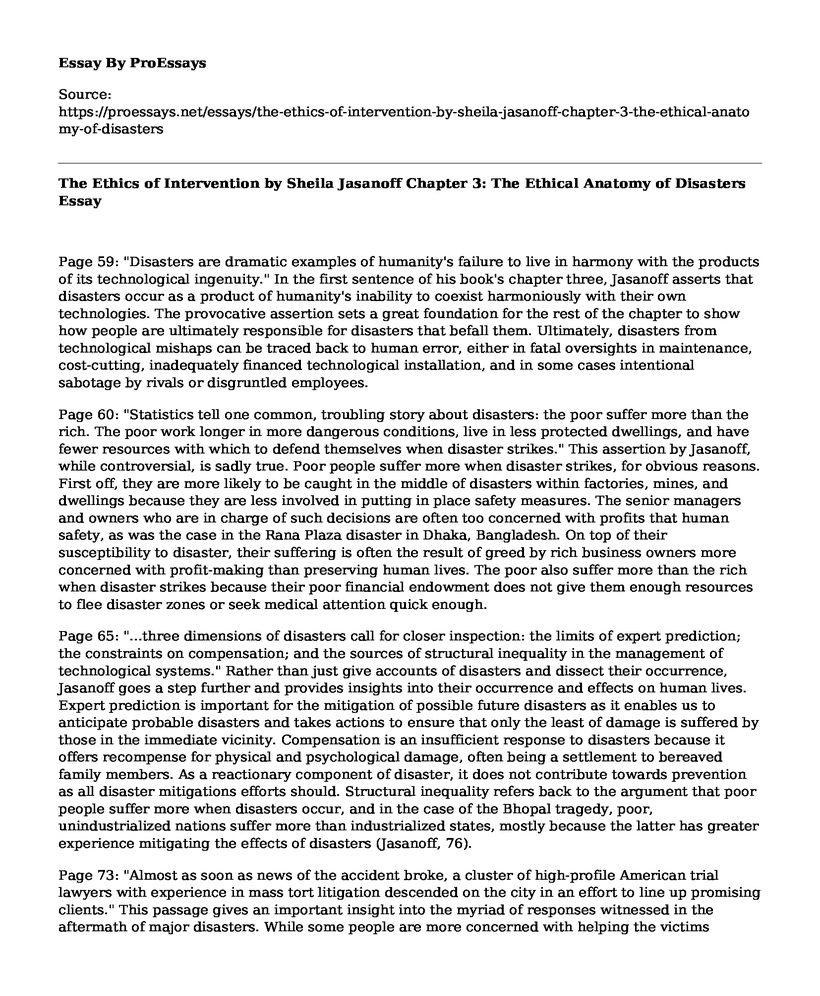Page 59: "Disasters are dramatic examples of humanity's failure to live in harmony with the products of its technological ingenuity." In the first sentence of his book's chapter three, Jasanoff asserts that disasters occur as a product of humanity's inability to coexist harmoniously with their own technologies. The provocative assertion sets a great foundation for the rest of the chapter to show how people are ultimately responsible for disasters that befall them. Ultimately, disasters from technological mishaps can be traced back to human error, either in fatal oversights in maintenance, cost-cutting, inadequately financed technological installation, and in some cases intentional sabotage by rivals or disgruntled employees.
Page 60: "Statistics tell one common, troubling story about disasters: the poor suffer more than the rich. The poor work longer in more dangerous conditions, live in less protected dwellings, and have fewer resources with which to defend themselves when disaster strikes." This assertion by Jasanoff, while controversial, is sadly true. Poor people suffer more when disaster strikes, for obvious reasons. First off, they are more likely to be caught in the middle of disasters within factories, mines, and dwellings because they are less involved in putting in place safety measures. The senior managers and owners who are in charge of such decisions are often too concerned with profits that human safety, as was the case in the Rana Plaza disaster in Dhaka, Bangladesh. On top of their susceptibility to disaster, their suffering is often the result of greed by rich business owners more concerned with profit-making than preserving human lives. The poor also suffer more than the rich when disaster strikes because their poor financial endowment does not give them enough resources to flee disaster zones or seek medical attention quick enough.
Page 65: "...three dimensions of disasters call for closer inspection: the limits of expert prediction; the constraints on compensation; and the sources of structural inequality in the management of technological systems." Rather than just give accounts of disasters and dissect their occurrence, Jasanoff goes a step further and provides insights into their occurrence and effects on human lives. Expert prediction is important for the mitigation of possible future disasters as it enables us to anticipate probable disasters and takes actions to ensure that only the least of damage is suffered by those in the immediate vicinity. Compensation is an insufficient response to disasters because it offers recompense for physical and psychological damage, often being a settlement to bereaved family members. As a reactionary component of disaster, it does not contribute towards prevention as all disaster mitigations efforts should. Structural inequality refers back to the argument that poor people suffer more when disasters occur, and in the case of the Bhopal tragedy, poor, unindustrialized nations suffer more than industrialized states, mostly because the latter has greater experience mitigating the effects of disasters (Jasanoff, 76).
Page 73: "Almost as soon as news of the accident broke, a cluster of high-profile American trial lawyers with experience in mass tort litigation descended on the city in an effort to line up promising clients." This passage gives an important insight into the myriad of responses witnessed in the aftermath of major disasters. While some people are more concerned with helping the victims recover and pick up their lives, some are more concerned with making a profit out of their suffering. The intention of these lawyers to represent the victims in American courts for a share of the settlement, and their desire to ensure that the case would set new records in settlement fees, further illustrates the man-eat-man nature of society.
Page 81: "Judge Keenan's faith in India's capacity "to stand tall before the world" reflects a confidence in the power of agency that some would say is characteristic of American social thought." In sharp contrast to the tort lawyers who flooded Bhopal to benefit from the disaster by representing victims is Judge Keenan's ruling to allow India to try Union Carbide, the American corporation responsible for the disaster. His expression of confidence in the Indian government's ability "to stand tall before the world" and try the case in India illustrates the higher ideals of human nature that allows us to emerge from disasters stronger and better.
Discussion Question
Is it possible for humanity to live with their new technologies without suffering any harm from them whatsoever? Are technologies inherently disaster-affinitive or is it wrongful use that creates disasters? What role do human ethics play in causing and mitigating the effects of disasters? What can be done to ensure that disasters do not harm people?
Works Cited
Jasanoff, Sheila. The Ethics of Invention: Technology and the Human Future. W.W. Norton & Company, 2016.
Cite this page
The Ethics of Intervention by Sheila Jasanoff Chapter 3: The Ethical Anatomy of Disasters. (2022, Jul 21). Retrieved from https://proessays.net/essays/the-ethics-of-intervention-by-sheila-jasanoff-chapter-3-the-ethical-anatomy-of-disasters
If you are the original author of this essay and no longer wish to have it published on the ProEssays website, please click below to request its removal:
- Daniel Quinn's Ishmael Essay Example
- Essay Example on Ethical Golden Rule
- Essay Sample on Real Monsters: The Power of Dismissing Love in Frankenstein
- Essay on The Ferryman: Act 3 Scene - A Thatcher-Era Guerrilla War
- Essay on Mary Shelley's Frankenstein: Social Psychology and the Search for Knowledge
- Exploring Ancient Greek Myths: Origins, Creatures & Heroes - Essay Sample
- Free Essay Example on The Roaring Twenties







